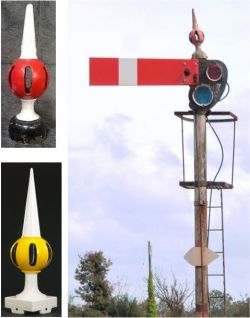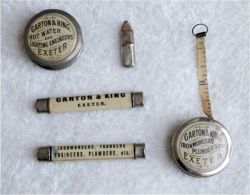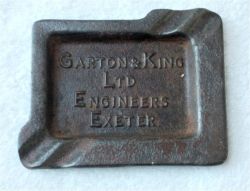

Three of these four topics are missing some factual detail but there is significant evidence for all three.
The ‘Third Rail’ topic comes about because of an email sent to me some years ago as an aside to the main topic that happened to be about Bell Frames. (see the Oddities page.) I have no reason to doubt the accuracy of the statement but, to use foundry terminology, I have been unsuccessful in finding cast iron evidence.
The ‘Hand Rail’ topic again lacks the evidence that a photograph would provide. Whilst tens of thousands must have visited Exeter’s Theatre Royal on Longbrook Street it seems that the Foyer Area of the Theatre was never considered a worthwhile area to photograph and my searches have, so far, drawn a blank.
The ‘Finial’ topic refers to Railway Semaphore Signal tops. All three of Henry Holladay’s sons can recall the mention of the foundry casting them but these items were not cast with the Company Name. They survive still on what was the Western Region of British Rail but were probably cast for pre nationalisation railway companies, in particular the Great Western Railway.
The fourth topic, ‘Freebies’ is totally accurate and provides a fourth subject that otherwise would not entitle it to a standalone page.
The comment in the email I referred to above stated:- “My own memories of the Garton & King Foundry are from an early 1960s visit when they had a contract to cast electrical pick-up shoes for London Underground trains.”
As you are doubtless aware London Undergound works on a Four Rail system. Usually the furthest (3rd) rail (when viewed from a station platform) is the positive rail. The centre rail is the negative return rail. The drawing below left is that of the Pick Up Shoe for 1938 Stock Tube Trains as would have been still operational in the early 1960s, as seen in the top Red image on the right. The 1959,1960 stock is represented by the lower Silver image on the right and were introduced into service in bare aluminium.
Somewhere I read that the shoe in the large coloured image (below right) is likely to be what G & K cast as they wear the most. This is the shoe one often notices arcing on a moving Underground Train as power take up moves from one length of pick up rail to another.
The far right image is from a series of 50 Cigarette Cards by John Player & Sons, of Nottingham in the Overseas Railway Working Series, dated 1927. I believe the Pick-Up Shoes, which were of Cast Iron, probably did not change much in design from one generation of Tube Trains to another. The hunt is on to find a genuine article but it is unlikely to be cast with the name Garton & King on it!
Anyone who visited the Theatre Royal on the corner of New North Road and Longbrook Street and who had Circle Tickets would have mounted the fourteen steps to the Circle Landing. Many would have sought reassurance and support from the railing on top of the ornate balustrade on either side of the staircase. They were probably unnoticed by most but appreciated by a few. The handrail was in brass and the ornate structure in wrought iron, not cast.
The Theatre I am referring to was opened in 1899 and eventually closed finally in 1962. Many readers may recall a variety of shows, and live performances. I remember attending many Pantomimes and admiring the many painted advertisements on the ‘Safety Curtain’ but it should be noted that it also presented melodrama, musical theatre, music hall and ballet as well as drama and for a period in the 1950s it showed CinemaScope Films.
Images of the interior and the Foyer Area seem to be non existent; I have searched high and low without success.
 A Finial is described as being an ornament at the top, end, or corner of an object and in this article refers to Railway Semaphore Signal posts, wood or metal, square or round; possibly to those affixed to the top of the pre-nationalisation Great Western Railway signal posts / gantries or those on the Western Region of British Railways.
A Finial is described as being an ornament at the top, end, or corner of an object and in this article refers to Railway Semaphore Signal posts, wood or metal, square or round; possibly to those affixed to the top of the pre-nationalisation Great Western Railway signal posts / gantries or those on the Western Region of British Railways.
These objects are very much sought after, often selling for over £200 at Auction. The marketplace includes reproductions and it is difficult to tell them from the genuine article.
I recall, as my brothers do, being aware that G & K cast finials for ‘The Railways’ whether in the pre or post nationalisation era or not I cannot say. It is said that the only method of identifying the foundry that cast them is by a Code . Each code relates to a specific Foundry. Examples held in the Malcolm Stone Collection at the Launceston Steam Railway include such codes as G49, G179C on the GWR Style Finials but I am unable to decipher the Code!
 In days gone by around Christmas and the New Year the Company Post, which I recall was always brought home for opening in the early morning by Alf Jackson, the Foundry Foreman, was awash with calendars, rulers, diaries, pens, letter openers and all manner of trade gifts and gismos. Quite what Garton & King gave away in those days, the 1950s, 1960s I really don’t know.
In days gone by around Christmas and the New Year the Company Post, which I recall was always brought home for opening in the early morning by Alf Jackson, the Foundry Foreman, was awash with calendars, rulers, diaries, pens, letter openers and all manner of trade gifts and gismos. Quite what Garton & King gave away in those days, the 1950s, 1960s I really don’t know.
Strangely enough examples of two styles of ‘give away items’ survive. A pencil with an oval covering sleeve showing the Company Name on one side and ‘Ironmongers, Engineers, Founders and Plumbers etc’ on the other.
The Tape Measure similarly shows the Company’s Skills and Trades but this time on one side it displays ‘Hot Water and Lighting Engineers’ and on the other ‘Ironmongers and Plumbers etc’. The makers name also appears – The Woodgate Press, 64 Aldermanbury, London EC. The objects in the upper image date to no later than 1925.
 The ash tray on the right was produced, probably in very small numbers, in iron and aluminium; these were produced by casting and not created by a press. It is probable they were produced as apprentice pieces and the pattern from which they could be cast was, from information I have gleaned and put together, certainly around in the late 1950s early 1960s.
The ash tray on the right was produced, probably in very small numbers, in iron and aluminium; these were produced by casting and not created by a press. It is probable they were produced as apprentice pieces and the pattern from which they could be cast was, from information I have gleaned and put together, certainly around in the late 1950s early 1960s.
June 2021
Top of page
See also:
Products — Railings — Transport
Little Bit Unusual — Mixed Bag — Oddities
144 Years of Newspaper Ads
Sitemap / Contents